What happens when faith leaders in Columbia are pro-choice? Page 24
EVEN THE PLAYING FIELD PAGE 5
MANUFACTURING MATTERS HERE
PAGE 16
TACO ‘BOUT CONNECTIONS


PAGE 29
ILLUMINATE PAGANISM



PAGE 33

THE VOICE OF COLUMBIA JAN/FEB 2023
Veterans, when you ’re struggling, soon becomes later becomes someday becomes ...when?




Don’t wait. Reach out .






Whatever you’re going through, you don’t have to do it alone. Find resources at VA.GOV / REACH


GIMME SHELTER
Where do you feel safe? What spaces and which people bring you ease? Finding these places of refuge grounds us, so it’s natural to seek them out.
Safety is often found in the familiar, and whether it’s the winding path of Rock Quarry Road or the reassuring conversations I’ve had in a Heidelberg booth, Columbia has given me safe havens amidst the chaos.
In this issue of Vox, we explore a couple of different safe spaces in the community. Local and regional sports leagues are establishing themselves as gender-affirming spaces (p. 5). In a personal essay (p. 7), a Vox writer reflects on how the horror genre helps us confront what scares us from a safe distance. The restaurant Carlito’s Cabo (p. 16) has been providing Peruvian-inspired Mexican dishes to patrons who consider the space an access point for quality conversation and food that tastes like home.

Faith and spirituality can be spaces for con-
nection and relief, and Columbians are hard at work maintaining that facet of the experience, even in the face of misconceptions. Local faith leaders are combating the conflation of religious beliefs with the rejection of reproductive rights (p. 24). Meanwhile, paganism is growing in popularity among Generation Z due to its open nature. Oak Spirit Sanctuary is just one of several places that are providing access to new ways of worshiping and connecting to the divine (p. 33).
As I wrap up my final semester on campus, I find myself moving over 1,000 miles away, leaving these safe havens behind in hopes of finding new ones in the next city. As you contemplate where your comfort zones are, consider what makes you feel secure. In my final letter to you, dear reader, I ask you to cherish those. Whenever you embrace the unknown, remember who’s waiting with open arms to shelter you if you need it. Take care of Columbia for me.
EDITOR-IN-CHIEF JANAE MCKENZIE MANAGING EDITOR ABBEY TAUCHEN DEPUTY EDITOR
REBECCA NOEL
DIGITAL MANAGING EDITOR MARISA WHITAKER
AUDIENCE ENGAGEMENT EDITOR KATELYNN MCILWAIN
ART DIRECTORS HEERAL PATEL, MOY ZHONG
PHOTO DIRECTOR MADI WINFIELD
MULTIMEDIA EDITOR HALLE JACKSON ASSOCIATE EDITORS

CULTURE SOPHIE STEPHENS, AUSTIN WOODS
EAT + DRINK JULIA EASTHAM, GRACE LEYDEN
CITY LIFE KARLY BALSLEW, JORDAN THORNSBERRY
STAFF WRITERS JESSE BERLIN, LAUREN BLUE, KARA ELLIS, ATHENA FOSLER-BRAZIL, TATEN JANES, JACEY JOHNSON, EMMA LINGO, CHLOE LYKKEN, JOE MILLER, GRACE ANN NATANAWAN, MARJAI NEAL, AMILEE NUZZO, PETRA RIVERA, SYDNEY SCALIA, KHALIA SMITH, JANE STEINBRECHER, ABBY STETINA
SOCIAL & AUDIENCE ANNA TIERNEY LEGGAT, MELANIE OLIVA, DAVID LYNN TALLANT, MADI WINFIELD
CONTRIBUTING WRITERS SOPHIA DONIS, OLIVIA MAILLET, ALYSE PFEIL, NATALIE-ELIZABETH TAN, LUCY VALESKI ART ASSISTANTS SIREEN ABAYAZID, CAMPBELL BIEMILLER, GRACE LEYDEN EDITORIAL DIRECTOR HEATHER ISHERWOOD EXECUTIVE EDITOR LAURA HECK
SENIOR EDITORS CARY LITTLEJOHN, JENNIFER ROWE OFFICE MANAGER KIM TOWNLAIN
Janae McKenzie Editor-in-Chief
Behind the issue
Standing in a crowd of people protesting the leaked Dobbs decision in May, I listened to the Rev. Molly Housh Gordon speak passionately about the fight for abortion access. I was surprised to see her, a church leader, protesting on the pro-choice side. And I began wondering why I was surprised — what was missing from the narrative that made a reverend engaging in activism so unusual? A combination of this question and Molly’s inspiring speech led me to propose writing a profile on her, the first version of the idea that evolved into a feature story about other pro-choice faith leaders in Columbia. The addition of more voices enriched the story exponentially, and I left every interview feeling touched by my sources’ wisdom and vulnerability.
Athena Fosler-Brazil
FOLLOW US
Vox Magazine @VoxMag @VoxMagazine @VoxMagazine

WANT TO BE IN-THE-KNOW?
Sign up to receive Vox ’s weekly newsletter, the “Vox Insider.” We’ll tell you how to fill up your weekend social calendar and keep ahead of the trends. Sign up at voxmagazine.com.
CALENDAR send to vox@missouri.edu or submit via online form at voxmagazine.com
ADVERTISING 882-5714 | CIRCULATION 882-5700 | EDITORIAL 884-6432
JANUARY/FEBRUARY 2023
VOLUME 25, ISSUE 1

PUBLISHED BY THE COLUMBIA MISSOURIAN LEE HILLS HALL, COLUMBIA MO 65211
Cover design: Sireen Abayazid and Moy Zhong

3
VOX MAGAZINE • JANUARY/FEBRUARY 2023
Photography by Madi Winfield and Beatrice Bankauskaite/Archive
^ . .
EAT + DRINK
29
A side of community Restaurant owners at Carlito’s Cabo aim to create authentic food and friendships.

31
No ‘perfect’ day of eating “What I Eat in a Day” content harms social media consumers.
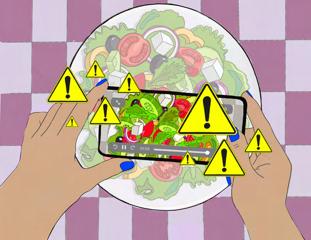
CITY LIFE
33
Season of the witch Columbia’s pagan community is everpresent and ever-growing.

35
E is for Earth
CPS teachers find modern ways to help students learn about climate change.



4
VOX MAGAZINE • JANUARY/FEBRUARY 2023 35 29 TABLE OF CONTENTS 16 05 14 31 IN THE LOOP 05 Finding refuge Community members build a safe place through team sports. 07 Horror is killing it Vox writer Lucy Valeski finds an outlet for expression in scary books and films. 09 Vox Picks Ring in the new year! 10 Now screening Kristal Sotomayor is the True/False Film Fest’s new programmer. CULTURE 11 Historical threads After 75 years, the Columbia Weavers and Spinners Guild perseveres. 13 Gallery in the gap Stop-gap projects uses its freedom to explore art and publishing. 14 Clay creations Find tiny houses from Snow Pond Ceramics around town. FEATURES 16 Fitting the parts together Vox talks with local manufacturers. 24 Putting faith in choice Pro-choice faith leaders discuss abortion.
Photography by Nicole Gutierrez, Kelsey Rightnowar, Lily Dozier and Kit Wiberg/Archive, collage by Heeral Patel and illustrations by Grace Leyden
Find refuge on the field
Inclusive leagues and organizations create safe places for all athletes.
BY JACEY JOHNSON


For years, Dakota Cole was looking for a sports team that would accept him as a transgender man. He finally discovered the Kansas City chapter of Stonewall Sports, a nonprofit sports organization for LGBTQ+ individuals and allies. Other LGBTQ+ sports leagues hadn’t been accepting toward Cole, but Stonewall was. From 2020 to early 2022, he was the kickball division lead for the Kansas City chapter.
“I’ve had top surgery, and there were games that I took my shirt off and no one made a comment about my scars,” Cole says. “The community and the environment is really, I think, what
people are looking for, more than just playing the sport.”
Discussions about transgender athletes have pervaded the world of sports, and transgender participation is limited or outright banned in numerous states. As of May 2022, 18 states had enacted laws or statewide rules of this sort, and in June 2022, Fédération Internationale de Natation, the world governing body for aquatics, banned transgender women from women’s swimming competitions.

Cole continues to play on a beginner-level kickball team with his wife, friends, family, allies and other people who joined as free agents, like he did
CoMo Roller Derby provides a casual atmosphere. “It’s one of the few sports that you can start in your 30s and it’s not weird,” says Casey Canfield, CoMo Roller Derby president.
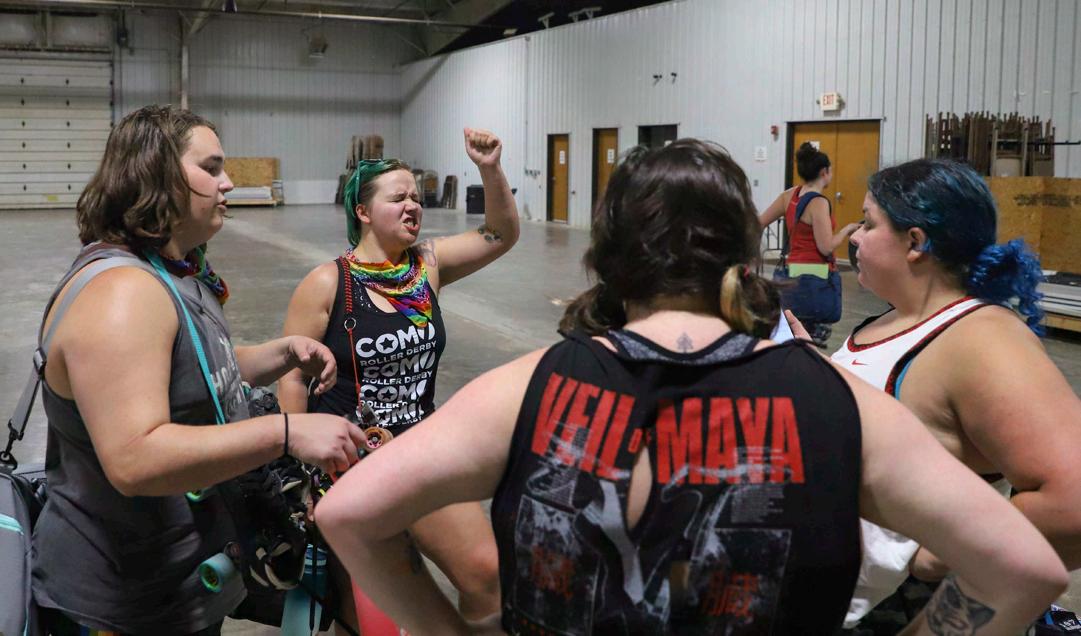
when he first joined.
“We wanted people of every sexual orientation and gender identity to speak to each other,” says Ryan Walker, the communications director for Stonewall Sports. “We wanted to build solidarity between people that maybe wasn’t there in the past because it’s very easy for any of us — regardless of identity — to be stuck inside of our bubbles.”
Stonewall Sports isn’t the only organization providing athletes with a safe space and encouraging others to leave their bubbles. Similar groups are present throughout the local community and not just for LGBTQ+ athletes.
5
VOX MAGAZINE • JANUARY/FEBRUARY 2023 SCREAM QUEEN P. 7 START OF SOMETHING NEW 10
Photography by Nicole Gutierrez and Madi Winfield and courtesy of Freepik
Recognizing women in sports Decades before Mitzi Clayton became board president of Columbia’s chapter of the Women Intersport Network (WIN) in fall of 2022, she was a member of the 1990 MU women’s track and field team. Her letter jacket was nylon, with an iron-on MU tiger adorning the back. The men’s jackets, meanwhile, were wool with leather sleeves.
She hung up that nylon jacket in her office while she worked with Mizzou Athletics from 2000 to 2018. In 2015, she was invited to a ceremony where woman letter winners received their “real” jackets. “That was the most moving experience I have ever been affiliated with in my time at Mizzou,” Clayton says.
WIN seeks to empower and recognize women in sports through award ceremonies and other events. The winner’s choice award, for example, is given to a women’s sports team that lacks a governing body in Columbia but competes at a national level, such as the Rock Bridge High School girls dance team.
Right now, Clayton is busy planning for WIN’s inaugural National Girls and Women in Sports Day event on Feb. 1, during which participants can sign up for free classes at local gyms across Columbia, such as Muse Pole Fitness and Athletics Performance Institute. WIN will partner with 10 local gyms and studios for the event. Registration opened Dec. 15.
Equipment for every student
Jennifer Turek, an English Language teacher at Hickman High School and sponsor for the campus multicultural club, is helping a student who wants to play on
CoMo Roller Derby has a significant LGBTQ+ presence. PrideFest is one of its biggest sources for recruitment.
NATIONAL GIRLS AND WOMEN IN SPORTS DAY
On Feb. 1, Women Intersports Network will partner with local gyms to offer free classes. T-shirts reading “All we do is WIN” will serve as tickets. To sign up, visit winforcolumbia.com.
the girls soccer team find a pair of cleats.
Soccer is a popular sport for international students at Hickman, and Turek recognizes that these students often share common needs, namely transportation and money for equipment. Her club meets once a month during the lunch period, so that students don’t have to stay after school like they would for many other clubs.
Wil Ross, the school’s head soccer coach, does what he can to encourage carpooling from practices when he knows of a student who doesn’t have a ride home.
“That’s where I think (international students) fall off or get lost,” Ross says. “They don’t have the means to travel and play club soccer like some of our domestic families.”
Ross says that Hickman’s five soccer teams provide a communal experience that might not otherwise be available to some international students.
Queerness in the rink
Historically, roller derby has provided female athletes with an outlet for physical expression they couldn’t find elsewhere. Casey Canfield, the president of CoMo Roller Derby, says this resonates with a lot of woman athletes.

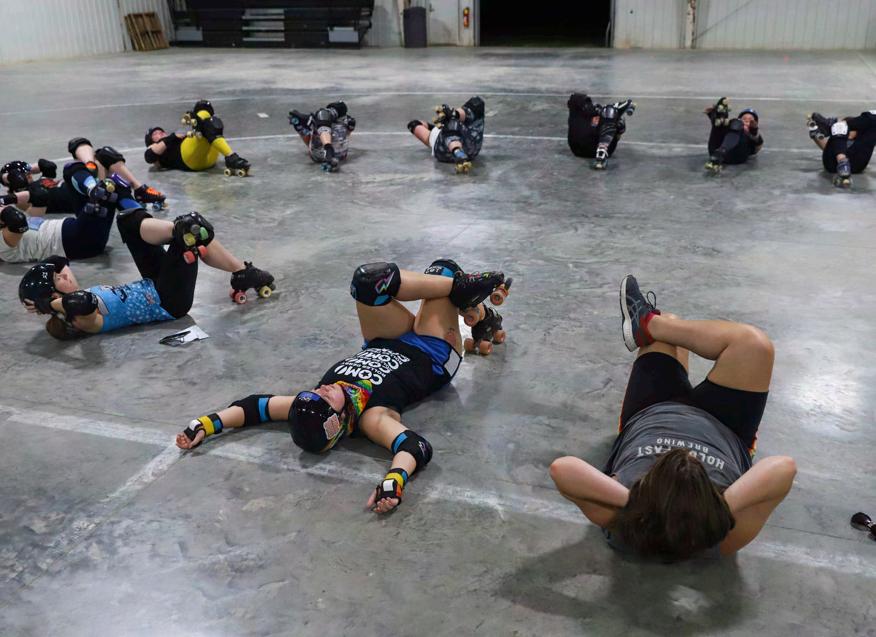
“Part of what’s fun about roller derby is that it’s a place that really encourages you to be aggressive,” Canfield says.
PrideFest is one of the team’s biggest recruitment events. The team sets up a booth at Kansas City’s event every year, and even participated in the pride parade held for the first time last year.
Kat Wright, a player and coach for CoMo Roller Derby, says they became involved with the team because they were looking for an inclusive atmosphere, with teammates that would respect their pronouns and welcome open, casual queerness.
CoMo Roller Derby meets the needs of communities that have historically been shut out from the sports world.
“It’s pretty cool to watch kids that might struggle with the English language come out to one of our soccer practices and, through soccer, be able to communicate with kids that have been speaking English since they were 2 or 3 years old,” Ross says.
“It’s just nice to be able to offer that for a lot of people who are questioning about gender identity because you know that however things shake out for you, however your identity flexes, there will still be a place for you there,” Wright says. “There will still be your people.”
6 IN THE LOOP SPORTS
VOX MAGAZINE • JANUARY/FEBRUARY 2023
Photography by Nicole Gutierrez
Horror is killing it
Gothic literature and film represent and reflect the scary realities we see in our world.
 BY LUCY VALESKI
BY LUCY VALESKI
Inever used to consider myself a horror fan, but if I list my favorite books, a clear trend emerges. Much of my favorite literature is in the gothic and horror genres. Books such as Shirley Jackson’s The Haunting of Hill House, Carmen Maria Machado’s Her Body and Other Parties and Oscar Wilde’s The Picture of Dorian Gray are the types of stories I gravitate to.
And it’s not just me. The current cultural moment is preoccupied with death, ghosts, monsters and jump scares galore. The fourth season of Stranger Things is Netflix’s mostwatched English language series ever. Of the six books on the shortlist for the 2022 Booker Prize, one of the world’s top literary awards, four contain ghosts and death-related themes. In 2020, the horror genre accounted for the largest percentage of total box office sales it ever has.
Why is the genre so popular during what already are anxiety-inducing times? According to a study published in Evolutionary Behavioral Sciences in 2020, horror helps people feel more in-control. “There may be a relief in seeking out situations that give you a blast of well-defined fear with a clear source and a crucial element of control,” says study co-author Mathias Clasen. “You know where the fear is coming from — the screen in front of you — and you know you can switch it off at any time.”
For me, my current interest in horror stems from a need to process the current cultural and political moment. Horror provides an outlet for expressing our very real anxieties about an ever-changing and uncertain world through the lens of the paranormal.
Although historical depictions of horror represent gendered stereotypes such as victimizing women, there have been recent contemporary female-centered narratives focusing on women as survivors and protagonists, such as Halloween (2018) and Midsommar (2019).
Fearing the past
Worries about the present aren’t the only fuel for horror. Gothic literature — a precursor to modern horror that’s often characterized by the occult, mystery and suspense — also uses conventions that inspire fear. “The gothic is predominantly about how the past continues to erupt in the present,” says Sheri-Marie Harrison, an associate professor of English and the associate dean of graduate studies and faculty success in the MU College of Arts and Sciences. This revival of the past within the present can propel people into a regressive reality, Harrison says.
The haunted house is a staple of the gothic genre. Specters haunt the protagonist after moving in. Characters live in
fear because ghosts, which are physical manifestations of the past, threaten their daily safety. “It’s the way that this house is supposedly haunted and impacting this young woman, but also it’s about how everything else outside of her life impacts her and collides into a perfect storm around the house,” Harrison says.
As a woman, I can feel the ways that the “house” we inhabit, the United States, poses a threat. When the ghosts of the past — for example, a lack of bodily autonomy — ripple into current legislation, we connect to haunted house stories. That could also be said for the experiences of people of color in this country or for marginalized groups as well. This validation of fear is cathartic.
7 IN THE LOOP ESSAY
Photography by Owen Ziliak VOX MAGAZINE • JANUARY/FEBRUARY 2023
Subversive portrayals
Like gothic tales, horror also can reveal fictional paths out of dangerous realities. “I think a lot of our strongest reactions to horror cinema is normally because we recognize something from that within ourselves,” says nonfiction writer Laura Maw.
Maw says women’s stories specifically have become more nuanced in recent years with more diversity behind the scenes. Some examples include Julia Ducournau’s body horror films Titane and Raw. “Over the last couple of years, we’ve seen a lot of really interesting female characters in horror films, not only on the screen but behind the camera,” Maw says. “This helps get stories that are a lot more nuanced and layered.”
Although horror has historically relied on misogynistic stereotypes, such as the socalled “final girl” — the last morally pure survivor of a horror film — Ted Rogers, cinema programmer at Ragtag Cinema, says genre films, such as horror, also tend to take risks.
I’ve also found that the metaphors in horror offer avenues for more diverse
stories to be told. While mainstream media might not have traditionally expected a woman to break (or break down) from societal expectations, horror novels tell stories with more radical subtext, such as Shirley Jackson’s The Haunting of Hill House. Published in 1959, the novel revealed the pressures of conformity and the idea of domesticity.
Building community

Horror can also be a way for people to find community through a shared love
HORROR PICKS
Check out Lucy’s favorite stories.
In The Dream House by Carmen Maria Machado
Hangsaman by Shirley Jackson
Bodies, Bodies, Bodies Director: Halina Rejin
Saint Maud Director: Rose Glass
and a shared space for experiencing these emotions.

“(Horror fans) want more people to love what they love,” Rogers says. “They want more of what they love. It’s the least amount of gatekeeping in any sort of niche community I feel like I’ve ever encountered.”
Young women tend to make up the primary audience for horror films, Rogers says. So it makes sense that for this year’s annual Ragtag horror film series, a majority of the selected films focused on women in the early 2000s. The films reveal the fears of heteronormativity, the male gaze, rape culture, purity culture and bullying — all told through analogous monsters.
The present can be a terrifying place. Pandemics, political extremism, climate disasters and the degradation of women’s rights are frightening subjects that invade my daily thoughts. Horror and gothic stories help me — and millions of fellow fans — channel those fears and relate to others who live in this scary world.
8 IN THE LOOP ESSAY
VOX MAGAZINE • JANUARY/FEBRUARY 2023
Photography by Owen Ziliak
Vox Picks for JAN/FEB
Each month, Vox curates a list of can’t-miss shops, eats, reads and experiences. We find the new, trending or underrated to help you enjoy the best our city has to offer.
BY TATEN JANES
Enjoy…


Scare…
Yourself with the upcoming thriller, The Villa by Rachel Hawkins, which hits shelves Jan. 3. It follows two reconnecting friends who decide to take a girls trip to an Italian villa with a dark past. Soon after their arrival, the duo finds themselves in a tangle of mystery surrounding the villa. Thrillers are popular right now (see our story on p.7). “People love thrillers when they can experience the fear without being in any real danger,” says Yellow Dog Bookshop owner Joe Chevalier. “That’s the draw.” Hawkins will discuss her book in St. Louis while on tour. The author talk is at St. Louis County Public Library, Grant’s View Branch, 7 p.m., Jan. 5

Listen…
The MO Fest music festival. Eight events will be hosted at The Blue Note and Rose Music Hall over the course of two weekends, each showcasing a specific musical genre such as funk, metal, soul, punk and much more. Catch Tri-County Liquidators at the Indie Fest and Meredith Shaw at the Country Fest. Explore a new genre or two at this local event featuring over 30 artists. The Blue Note and Rose Music Hall, 8 p.m. , $8-10 general admission, $15 tables, Jan. 6-7 and 13-14, thebluenote.com
Celebrate…

The Lunar New Year on Jan. 22 by making traditional dumplings. Dumplings represent wealth, and tradition says the more you eat, the more money you will make in the new year. 2023 will be the Year of the Rabbit, which symbolizes longevity, peace and prosperity. Support local Asian markets by picking up ingredients for traditional New Year’s foods such as nian gao (rice cakes), tang yuan (sweet rice balls), tteokguk (rice cake soup) and bánh chuôi (banana cake). Hong Kong Market, 2006 Broadway; Lee’s Market, 700 Cherry St.; Shwe Market, 800 Vandiver Drive
Swing…
At the Jazz in the District show featuring Gram my-nominated musician Elio Villafranca and Friends. Villafranca is a renowned jazz artist, having worked with big jazz names such as Pat Martino and Terell Stafford. Enjoy a night with these classically trained musicians as they perform as part of the “We Always Swing” Jazz Series. Missouri Theatre, 6 p.m., Jan. 29, $25, wealwaysswing.org
To the Lviv National Philharmonic Orchestra of Ukraine perform Ukrainian music. The orchestra was established in 1902 and has performed in many countries, including Poland, Italy, Spain, France, Switzerland, Germany, the Netherlands and China. The 2023 American tour currently has seven stops, and the Columbia location is hosting the final concert. Despite international turmoil, the orchestra has been going over 100 years strong. Jesse Auditorium, 7 p.m., Feb. 25, $33–45, concertseries.missouri.edu

IN THE LOOP VOX PICKS
Photography courtesy of Kasia Idzkowska, Macmillan, Beatrice Bankauskaite/Archive and Unsplash and zaie/Freepik
^ . .
Now screening
As a new True/False programmer, Kristal Sotomayor uses their platform to bring Latinx voices to the forefront.
BY KHALIA SMITH
With an ambitious and dedicated persona, Kristal Sotomayor is making their mark on the film industry. Sotomayor, who uses they/she pronouns, joined the True/ False Film Fest team as a film programmer in September.

Sotomayor’s career started with an internship programming for the PBS showcase, POV , which is television’s longest-running showcase for independent films. Sotomayor then became the programming director for the Phila delphia Latino Film Festival and has programmed for Tri-Co Film Festival in Pennsylvania and the San Francisco International Film Festival in California.
Prior to working for True/False, So tomayor was an attendee. Their love for the festival is one of the reasons they caught the eye of the artistic director, Chloé Trayner.
“I think the thing that stood out when we spoke to Kristal about the role was their excitement for the possibilities of Columbia itself and hearing them talk about past experiences at True/ False,” Trayner says. “Especially how, for them, a key part of the fes tival was meeting local audiences.”
Vox spoke with Sotomayor about their background and future with True/False.
How did you get into film?
I’ve always loved film. When I was in middle school and high school, I was a Turner Classic Movies channel nerd. So I always loved Humphrey Bogart films, and Vivien Leigh, and all of this cinema that really was not super representative, but I loved the stories. I just was kind of obsessed with that world. It wasn’t until I went to college that I realized that’s what I wanted to do.
What is it like to be a film programmer?
I love film programming. It’s so wonderful. It’s the curation of films in a way to elicit feelings or questions from a specific audience that you’re trying to target. What I love is to program short blocks because I feel like that’s where a lot of the curation kind of falls for me. I like to curate a block of shorts — which is three, four or five shorts — especially a block that has a specific theme, idea or feeling that I want people to
der of films that you have selected. It’s like putting together an exhibition, in a way, to view other people’s art and to elicit a specific audience feeling, emotion, idea or question. And really, it’s elevating other people’s art. I do think curation itself is art because there was a lot of deliberation and thought put into each section.
How will you add your own touch to the True/False Film Fest?
I think wherever I go, I try very hard as a programmer to bring Latinx voices to the center. One of my missions is to reach out to different filmmakers throughout Latin America and throughout the Global South and try to get more of their involvement. So for me, centering Latinx voices, Caribbean voices, Indigenous voices and Afro Latino voices is super important.
How are you utilizing your platform as a way to advocate for people like yourself?
I’m emerging in the field, and I wouldn’t have gotten here if it wasn’t for Black and Latina women that were my advocates, that were my mentors, that opened doors for me, challenged me and listened to all of my hopes and dreams and helped me get there. So I absolutely want to give back, and my goals are absolutely to ensure that other diverse storytellers are being heard and listened to, and especially storytellers that are not based in the United States and have access to even less resources.
10 VOX MAGAZINE • JANUARY/FEBRUARY Photography courtesy of Purple PPL Media IN THE LOOP Q&A
New True/False Film Fest film programmer Kristal Sotomayor is ready to bring diversity and inclusion to the fest’s 20th edition in March 2023.
Historical threads

How the Columbia Weavers and Spinners’ Guild stays true to its original mission 75 years later.
 BY LAUREN BLUE
BY LAUREN BLUE
On January 9, 1947, eight women founded the Columbia Weavers Guild. The original members were spouses of men working at MU. They met donning white gloves in a formal setting. The first president of the guild was Wynona Chilcott, who was one of the charter members along with fellow ladies of the loom, Mrs. Frank L. Matt, Mrs. Ralph Watkins and Mrs. Frederick Dunlap.
At the time, women weren’t allowed to join traditional, formal art institutions, like academies, leading them to turn to fiber arts as a way to engage in the culture. The guild’s mission is to serve as an educational organization “to increase public awareness and to enhance the appreciation of all aspects of fiber arts,” according to the guild’s website.

A year after the first meeting, the guild had its first exhibit showcasing the women’s work at the Boone County Fair. Seventy-five years later, the guild has lost the gloves, altered its name to include spinners and now has around 80 members, but education is still a core principle of the guild.

Getting started: Fastening the warp
Across many cultures, weaving has historically been regarded as women’s work. Women, often constrained to their husbands’ or fathers’ homes, took on the bulk of the weaving and textile effort for families and communities in many ancient civilizations, including in the Roman Empire. Roman women
11 VOX MAGAZINE • JANUARY/FEBRUARY 2023 TINY HOMES, BIG HEART P. 14 MIND THE GAP P. 13
Photography by Cora Mitchell, Shane Palma and Kelsey Rightnowar
Leah Guerrero knits during a business meeting of the Columbia Weavers and Spinners Guild at Bethel Baptist Church.
would oversee weaving in their house, says Katherine Iselin, an instructor in both the Women’s and Gender Studies and the Art History and Visual Studies programs at MU. Iselin says weaving was seen as a way for women to occupy their hands while remaining silent and still creating functional art such as clothes and tapestries.
The practice of weaving often ended up being a communal endeavor passed down from mother to daughter or between friends, Iselin says. It wasn’t until the Renaissance that guilds were created and became more commercial. Eventually, this art became a medium aristocratic women were expected to engage in, a way to demonstrate their eligibility for marriage and ability to run a household.
Looking at textile arts can help show history outside of typically male-dominated art spheres. “Because we live in a patriarchal society, the forms of art dominated by men were considered the most important,” Iselin says.
Iselin says the way to remedy this is
by exploring the history of textile arts and acknowledging its significance as an important form of visual and material history. The founders of the guild tried to do this since its start.
“That’s what the guild does,” says Debbie Schluckebier, a member of the guild since 1988 and an anniversary planning committee member. “We want to make fiber arts visible in the community and, basically, emphasize education.” The guild’s study groups and partnerships with local schools are two ways it incorporates education.
Finishing touches: Binding off Mike Knoll, a 32-year-old guild member who joined in 2021, originally found out about the organization through his weaving teacher at Access Arts, an art studio in Columbia offering classes to youths and adults. He didn’t know much about fiber arts before starting in 2015, and he was a little surprised when he realized he was substantially younger than many other artists and one of the only men
WEAVING IN EDUCATION
The guild incorporates education through study groups, which are split up based on forms of fiber arts including felting, knitting, crocheting and general fiber arts. The study groups meet monthly in addition to guild meetings. Learn more at cwsgcomo.org.
in his classes. However, it didn’t scare him away from fiber arts.
Despite the guild’s older demographic and long history, Schluckebier believes the key to ensuring the guild continues is getting younger members to join and that the guild stays open to current trends.
Right now, a trend in fiber arts is emphasizing sustainability, and Schluckebier says the guild is exploring new materials that can be repurposed and reused. They use materials like cattail leaves and iris leaves to make baskets and reuse old sweater fibers to make something more up-to-date.
Schluckebier says the guild is always open to studying new fiber arts trends.
“We’re not old fogies, you know,” Schluckebier says. “We’re always in stuff that’s coming out and new stuff. I think we’re ever–evolving because of that.”
Schluckebier hopes the guild continues to grow and educate the Columbia community, with the goal of one day having its own meeting space for members to do any kind of fiber arts.
Small businesses fuel our local economy, create jobs, and keep Columbia the vibrant place we all love. discoverthedistrict.com
12 VOX MAGAZINE • JANUARY/FEBRUARY 2023 CULTURE ART
Gallery in the gap
Stop-gap projects gives control back to artists.
BY LAUREN BLUE
Ten shows and 15 featured artists, all over the course of 12 months. During the first year of stop-gap projects, what started as a dream quickly snowballed into a fully formed, functioning gallery, run by artists, for artists. “It went from this idea to really real, really quickly,” owner Anna Wehrwein says.

Wehrwein wasn’t originally looking for a space when she stumbled across the location that would eventually become stop-gap projects, a downtown Columbia gallery. The landlord of the space was even willing to work with them on rent while she and her close friend and colleague Fidencio Fifield-Perez got the gallery up and running. But there was one caveat: They had to act now. “If we wait to have a plan, it’s not going to happen,” Wehrwein says. Knowing an opportunity like this wouldn’t present itself again, they moved into the space in November 2021, and within a month, stop-gap projects had its first show.
Why stop-gap?
The name “stop-gap” is a reference to the potentially temporary nature of the gallery itself. With a 6-month lease, Wehrwein accepted that the future of the gallery was uncertain. “It doesn’t have to be forever for it to be worth it,” Wehrwein says. She says another aspect of the name that inspired her is the idea that a stop-gap is born out of need. Wehrwein felt that Columbia needed a space for installation and curatorial work that wasn’t commercially focused.
“There’s that moment when you’re like, ‘How many times are you gonna complain about the lack of Columbia art scene, and when are you going to do something about it?’ ” Wehrwein says.

The gallery focuses on the artists, what they want to do and the ideas they have. Wehrwein says artist-run spaces allow for more experimentation than a
more traditional gallery or museum setting might allow. It also frees them from the burden of worrying about profits.
“Our business model is that if work sells for the artists, we take no cut of it,” Wehrwein says. “We’re very un-sales motivated. It’s about the work and space and the conversations it creates.”
Kimberly Kitada, gallery and programs manager at Charlotte Street Foundation, a Kansas City organization that provides resources for artists, agrees that artist-run spaces allow for more freedom. Kitada says part of the difference is due to the stakeholders. In a museum, there is almost always a board of trustees and similar roles the curator must report back to. Even if these people aren’t taking an active role in the museum’s exhibitions, Kitada says curators still are always updating them. She also says there is a greater sense of autonomy in artist-run spaces.
“You can kind of be doing your own thing and not necessarily reporting back
Stop-gap projects is an artist-run space, which gives it more freedom than traditional galleries or museums. Cesar Lopez’s art piece, above, displays World Cup-related tweets on receipt paper. One tweet reads: “As a latina, Ghana I (am) pulling for yall with this penalty. You deserve the redemption”
STOP IN
The gallery, 810 E. Walnut St., is open on the first Friday of every month from 6 to 9 p.m. Viewing appointments can be made by emailing stop.gap.projects@ gmail.com.
to people,” Kitada says. “So it generates a lot of new ideas.”
More art, more freedom
Stop-gap projects has used this freedom to explore the art of publishing over the past year. Publisher-in-residence Connor Frew, who uses he/they pronouns, makes accompanying textual art for the gallery’s exhibitions with his publishing practice, Flatpack Publications. The work is displayed in a section of the gallery called The Reading Room. Frew’s idea for the project explores the concept of an open draft and opening up a work for viewing, even if it doesn’t feel finished quite yet.
“The thing I love about The Reading Room is that it is like a series of attempts that have possibilities that come from them, and those possibilities are what I read out of them,” Frew says.
“The possibilities within the work are what I think is really interesting because, to me, none of it is finished.”
Although stop-gap creators might not know where the gallery will be in a year, they do have programming planned through the spring. The gallery will also be collaborating with more Columbia-based organizations such as the True/ False Film Fest.
“(Creating the gallery) was a way to be like, ‘Yeah, let’s try to make more in this community or have another voice in the art scene,’ ” Wehrwein says.
13
JANUARY/FEBRUARY 2023 CULTURE ART
Photography by Cora Mitchell VOX
MAGAZINE •
Cesar Lopez debuted his art gallery, La Onda, on Dec. 2 at stop-gap projects.
Her clay creations might be hidden under your nose

Katie Barnes makes — and sometimes hides — tiny houses through her business, Snow Pond Ceramics.
 BY AMILEE NUZZO
BY AMILEE NUZZO
If you find yourself walking along Ninth Street or Broadway, you might be lucky enough to find a tiny house nestled between tree branches, squeezed next to bricks or on the register of your favorite bagel shop. No, those weren’t left by accident. They’re from artist Katie Barnes. She turns 25-pound blocks of clay into 75 or more tiny houses, match boxes and Christmas trees under the name Snow Pond Ceramics and sometimes hides them around town.
Making a little magic
Snow Pond is where Barnes and her husband, Max Bittle, used to live in Concord, New Hampshire. “We lived in a little red cabin on Snow Pond, and it was a magical place and a magical time in our lives,” she says.
Barnes brought the magic from Snow Pond to Columbia in a unique way. First, she cuts porcelain clay into cubes that dry for a few days. Then, she carves, shapes and decorates them before leaving them out to dry. Pieces with color are hand painted, then bisque fired, which makes the product more durable. Next, the houses are dipped in a clear glaze, re-fired and are ready to be sold or hidden throughout the city.
“I make so many of them, and I think they’re just so cute and funny,” she says. “I hide a lot of them downtown.”
Barnes has left her tiny houses in tip jars, bus stops and the steps of the Columbia Public Library, along with other places. She said she loves the idea of people finding them on their walks, so she’s always sure to keep a handful of them with her — an entire village in her purse. Out of 300 to 400 hidden

houses, 30 people have reached back out to her with their discoveries.
Small beginnings
Barnes has been working with clay since 1998, but the tiny houses started in 2020, when her studio shut down and she wanted to entertain her family during the COVID-19 lockdown.
“The kids were really bored one day, and I had some clay,” she says. “So, I was like, ‘Let’s just play at the kitchen table,’ and I started making these really simple, little houses.”
When the hobby turned into a business, it remained a family affair. After the finished products are brought home, her sons Jack and Charlie Bittle organize the
14
CULTURE ARTISTS VOX MAGAZINE • JANUARY/FEBRUARY 2023
Photography by Kelsey Rightnowar
Katie Barnes spends part of the year working with ceramics and another part as a wedding photographer with her husband.
During the pandemic, a local pottery studio began giving away free clay, enticing Katie Barnes to begin exploring handcrafted clay art.
trinkets into little villages. “We like to set them into different sets; it’s fun,” says 9-year-old Jack.
The combinations are set up by the boys before they are photographed and listed for sale on Barnes’ Etsy page.
Peg Craig, the owner of Squarepeg Art Studio, ensured Barnes could still create ceramics during COVID-19 by letting her use the studio to fire her work.
“Katie has such an incredible eye for things,” Craig says. “She really has a good eye (for) what’s important and what draws people in.”
Design with purpose
To get the details and textures on her houses, Barnes often recycles household items as tools such as Crayola marker caps, plastic baby knives and her homemade clay window stamps. Beyond these, she has ordered custom-made stamps with her business name and other, more complex designs.
Lately, she’s been turning her houses into match strikers, as she loves making things that serve a purpose. To do this, she leaves one side of the roof textured and unglazed so a strike-anywhere match can be lit. When pottery is put in the kiln, the item should generally be hollow to prevent cracking, but these are not.
“I have never had anything crack in the kiln,” Barnes says. She thinks this is the case because she typically works with compressed clay straight from a processing plant.
For half of the year, Barnes and her husband photograph weddings in Massachusetts. The wedding season is from June to December, and her clay season is from January to May. With clay season in full swing, she has plenty in stock, but will start creating more houses in the next couple months.
“I just can’t wait to start making them again,” Barnes says.
Always thinking of new ways to give her tiny ceramic houses other purposes, Katie Barnes creates match strikers and tiny plant pots.


THE FIRING PROCESS
Bisque firing
The first firing of a ceramic piece to make it firm enough to handle and possibly glaze.
Single firing
The process of firing a ceramic piece just one time to yield the end product.
Sintering
Solidifying a ceramic piece by heating it until its component materials bond together.
Twice firing
The process of firing a ceramic piece once, glazing it, then firing it again. This is often the final step in the creation process.
SHOP TINY
Find Snow Pond Ceramics on Etsy at etsy.com/shop/ snowpondceramics or on Instagram @snowpondceramics.
15
•
2023 CULTURE ARTISTS
Photography by Kelsey Rightnowar VOX
MAGAZINE
JANUARY/FEBRUARY
Fitting the parts together
Missouri’s robust manufacturing industry is thriving in Columbia. Despite its impact on our economy and infrastructure, it can be relatively unseen. Vox turned to local manufacturers to explore how it’s much more than factories and supply lines.
 BY AMILEE NUZZO
BY AMILEE NUZZO
Made in Columbia and future of manufacturing businesses in Columbia.

16 VOX MAGAZINE • JANUARY/FEBRUARY 2023
Photography by Samantha Waigard/Archive and courtesy of Unsplash
Out of the 43 largest employers in Boone County, 10 of them are manufacturers in Columbia and Centralia. The locations of these companies, large and small, produce a wide range of products and services, from parking brakes and medical equipment, to hot dogs and oatmeal. Here’s an overview of the history of these manufacturers.

1970 - 3M When looking at the 3M logo, office supplies are likely what comes to mind. But the Columbia plant, which opened in 1970, creates sterilized solutions to protect surgical patients from infections with products like purification filters and medical diagnostic products. 3M’s purification filters help patients with autoimmune diseases
and cancer, and its diagnostic supplies are used to test for food pathogens in DNA. The plant’s largest products are Littman stethoscopes,which offer enhanced acoustics and active noise cancellation. After shifting its production to the medical field around 2006, 3M Columbia was able to find additional customers and increase its staff.
 Design by Heeral Patel
Design by Heeral Patel
17 VOX MAGAZINE • JANUARY/FEBRUARY 2023
Edited by Karly Balslew, Julia Eastham and Grace Leyden
Photography by Taz Lombardo/Archive
Add up the numbers
Learn the stats behind the state’s third-largest industry.
BY LAUREN BLUE
Manufacturing has literally and figuratively built America, says Jeff Pinkerton, the director of economic research for the Missouri Department of Economic Development. He says industry serves as the country’s backbone, and Missouri is a major player in manufacturing. Liz Sharp, vice president of investor relations at American Outdoor Brands, says that the state is appealing to manufacturers because it is in the middle of the United States, making it a good distribution hub for shipping.
From creating the product to shipping it to consumers, Missouri does it all.
266,439
That’s the number of manufacturing jobs in Missouri. Manufacturing has a unique economic impact because every job in manufacturing creates more jobs through needed utilities, infrastructure and the goods that go into the industry, Pinkerton says.
$37.9 billion
Manufacturing contributed billions of dollars to the 2020 gross state product, which is the total output from all the industries in the state, Pinkerton says. That’s 11.8% of the state’s total.
$61,842
As of 2020, this is the average manufacturing annual wage in Missouri. That number is higher than the average salary in Missouri for all industries, which was $51,390 as of May 2021.
Manufacturing wages continue to rise in Missouri and nationally. Pinkerton says competitive wages also contribute to manufacturing’s impact on Missouri’s economy. “Manufacturing has really been a stable source of employment for Missouri,” he says.
According to the Regional Economic Development Inc. (REDI), in Columbia, the mean hourly wages range for manufacturing-related jobs.
• First-line supervisors of production and operating workers: $30.89
• Industrial production managers: $28.01

• Team assemblers, miscellaneous assemblers and fabricators: $17


• Laborers, freight stock and material movers: $14.08
Third Mardy Leathers, director of the Missouri Office of Workforce Development, says that manufacturing is the third-largest employing industry in the state. According to REDI, in Boone County, the largest manufacturing employers are:
• 3M: 489 employees
1978 - Schneider Electric Schneider Electric’s Columbia location opened in 1978. This company has many products and services, including solar and low or medium voltage systems. Low voltage systems include circuit breakers and switchboards. Medium voltage systems provide service for more commercial buildings, healthcare and data centers. The solar systems can be installed for commercial areas, residential areas and microgrids.
• Kraft Heinz: 440
• Dana Light Axle Products: 380
• Quaker Oats Company: 360
• Beyond Meat: 300
• Watlow: 265
• American Outdoor Brands: 174
• Aurora Organic Dairy: 130

• OTSCON: 118
These numbers were reported in 2020 or prior. That is a combined 2,656 jobs. One misconception about manufacturing jobs is that the work is “unskilled labor.”
However, Pinkerton says that in an increasingly technological world, requirements for workers in manufacturing plants have only risen. He says manufacturing isn’t the same as it may have been when his grandfather was around. Instead of a dusty, hot floor, facilities nowadays are filled with robotics and computers.
“(Manufacturing plants) require higher skilled individuals, people who are just as comfortable behind the keyboard as they are turning a wrench,” he says. “We need both of those in our in our manufacturers.”
1.11
Missouri has a local quotient of manufacturing jobs of 1.11. The local quotient
1979 - Watlow The Watlow facility in Columbia was opened to manufacture flexible and ceramic fiber heaters. According to its website, Watlow serves several industries with clinical equipment, food service equipment, semiconductor processing and environmental technologies. It manufactures different types of heaters and several temperature sensors and controllers, which are all parts of thermal systems.
1818 VOX MAGAZINE • JANUARY/FEBRUARY 2023
Photography by Shelby Baseler/Archive and Owen Ziliak/Archive and courtesy and Unsplash
compares an industry’s regional number to the national number. A local quotient of over 1 shows that Missouri has a greater number of people employed in manufacturing than the nation as a whole. Seventy-two of Missouri’s 115 counties have a local quotient over 1.
Leathers says that Missouri’s lower taxes and the abundant workforce in Boone County also draws in manufacturers.
400
That’s the number of new jobs two new plants are bringing to Columbia. Aurora Organic Dairy began production construction in 2019 and created 100 new jobs in the city. In a 2021 expansion, it brought 50 additional jobs and a $50 million investment. In August 2020, Swift Prepared foods announced its plans to build a $200 million facility in Columbia to employ more than 250 people.

Inside Columbia’s largest medical manufacturer
Stethoscopes are at the heart of the local 3M plant.
BY GRACE ANN NATANAWAN
Columbia’s 3M production facility has been at the forefront of medical manufacturing for almost 20 years. Employing over 500 people and making 50,000 stethoscopes per week, the Columbia plant dedicates itself to refining the manufacturing processes of its medical technology.
The 160,000-square-foot facility primarily served as a production space for electronic circuits, microwave products and overhead projection manufacturing before pivoting to developing medical diagnostic products in 2003. From there, 3M Columbia expanded its medical manufacturing practices, focusing on healthcare products that involve infection prevention, food safety and medical diagnosis.
Workers specialize in different areas such as biotechnology, molding, precision processing, microbial detection and control and more. Each area is vital to the technological processes of the plant, ensuring that the products created are dependable and efficient.

Its current production slate includes Littman stethoscopes, barrier films, liquid medical products, purification filters and medical diagnostic products.
Barrier film produced at the facility is used in solar panels, high definition displays and window film.
3M Columbia’s focus on clean-room manufacturing and extensive laboratory capabilities lead way to an emphasis on infection prevention and medical diagnostic products. The manufacturing of liquid medical products is used to sterilize and protect surgical patients from infections.
Dr. David Littman, a Harvard Medical School professor, transformed the rudimentary stethoscope by improving its acoustical performance in the early 1960s, allowing the user to more clearly listen and diagnose. Later, 3M acquired Littman’s business and proceeded to refine the designs.
According to 3M’s website, Columbia’s facility is able to streamline the complex manufacturing process of the Littman stethoscope. Finalized products are shipped globally after completing the manufacturing process at the Columbia plant. Similar 3M Missouri production centers are located in Springfield and Nevada, Missouri.
Outside of the factory, 3M Columbia seeks to be involved with causes that strengthen the community and contribute to the area. 3M Columbia contributes resources to the American Red Cross, Columbia STEM Alliance, First Robotics and the Food Bank of Central & Northeast Missouri.
1980 - 3M expands In 1980, 3M added an 80,000-square-foot expansion to the Columbia factory. The company stopped focusing on the microwave product business in 1986, and shifted its focus to security systems. By 2006, the company was involved in medical diagnostic products.
1985 - Kraft Heinz Kraft Heinz began its Columbia business in 1985 with 150 employees. This plant focuses on Oscar Mayer, one of the brands owned by Kraft Heinz. It is the only Oscar Mayer plant with 24/7 production and the only one that exclusively makes hot dogs, making the semifrequent Weinermobile sightings in town a little less surprising.
19 VOX MAGAZINE • JANUARY/FEBRUARY 2023
Photography courtesy of Brian Schmittgens
The weakest link: How supply chains break down
Where Missouri fits in the flow of goods from producers to consumers.
BY SYDNEY SCALIA
Supermarket wastelands of vacant shelves were common during the 2020 lockdowns. Months later, the shelves still remained empty, and more products fell into short supply. Broken global supply chains were among the culprits, trickling down to every sector of manufacturing and distribution imaginable, leaving businesses devastated. Almost three years later, some things have changed, but some things have stayed the same. Vox spoke with supply chain experts from all over Missouri to explain exactly what happened to supply chains and what’s happening now.
More demand than supply
A supply chain is a long network that connects producers and consumers through the distribution of commodities. These commodities can be as small as microchips for cars, or as big as commercial airline parts. The Governor’s Supply Chain Task Force is a five-member team created in 2021 by Gov. Mike Parson. One member, Chris Gutierrez, the president of the economic development and industrial activity company SmartPort, based in Kansas City, explains the supply chain is the global movement of product from the point of origin to the point of
destination or the movement of the final product itself to the consumer.
The cycle of the supply chain heavily relies on different modes of freight transportation, such as trucks, trains, boats and aircrafts. According to the American Trucking Association, trucks move over 70% of the nation’s freight. Even before COVID-19, the freight industry had difficulties keeping up with the supply chain. “The challenges right now have always been there,” Gutierrez says. “It’s a difficult thing when you have multiple players moving freight around the world.” When COVID hit, the challenges only grew.



Worldwide shutdowns froze the supply chain, with Asia being one of the first regions to fall. “You had manufacturing plants in Asia that stopped producing product, which then caused the truck and rail and ports to shut down,” Gutierrez says. But that didn’t stop the demand from consumers at home, causing a quick rise in the market demand. “Once you turn something off and then turn it back on at higher volumes, it causes delays,” Gutierrez says. “Volume was increasing at a rapid rate, and the supply chain didn’t have the ability to move it.”
1988 - Dana Light Axle Products Dana Inc., the parent company of Dana Light Axle Products in Columbia, was founded in 1904. This company has experienced major changes in the automotive industry, providing products for vehicles like the Model T and World War IIera Jeeps, and the first battery-electric vehicles. Since 1988, Dana Inc. creates transmissions, drive shafts, heat shields and axles for commercial, off-highway and passenger vehicles in Columbia.
1993 - OTSCON OTSCON was established in 1988, and opened its Columbia factory in 1993. Another local company that makes car parts, OTSCON focuses on parking brake and brake pedal assembly, stamped components and injection molding. OTSCON might not be a familiar name, but the company has products that Honda, Subaru, Nissan and more include in their vehicles.
20 VOX MAGAZINE • JANUARY/FEBRUARY 2023 Photography courtesy of Unsplash
Trains, planes and automobiles —plus trucks and barges — are all a part of the delicate supply chain that fills our store shelves.
Congestion of barge transportation is creating problems right now in Missouri. Barges on the Missouri River that are responsible for transporting corn and soybeans have been halted due to travel restrictions from low water levels. Mary Lamie, executive vice president of multi-modal enterprises for Bi-State Development and member of the Governor’s Supply Chain Task Force says the congestion is just another example of local supply chain disruptions happening today. “Right now, farmers and shippers are stockpiling their corn and will likely wait until the river levels come back up,” Lamie says. This congestion then leads to a spike in food prices, fuel prices and other prices due to the delays, Lamie says.
Repairing the links in the chain
It’s not all doom and gloom. Lamie attributes Missouri as a “reliever” of some of the issues the supply chain has faced by tackling multi-million dollar projects to support manufacturers and build up infrastructure. “Not only are we trying to support the existing manufacturing companies, but by maintaining it and adding capacity to Interstate 70, that’s going to allow opportunities for expansion for those companies,” Lamie says. A statewide initiative will create an all-water route shipping system that stretches down to Louisiana ports through the use of the Mississippi and Missouri rivers. “This is an innovative way that the state of Missouri is looking for ways to be part of the solution for supply chain disruption,” Lamie says.
Even right as COVID-19 hit, repairs were already being made to the supply chain as quickly as possible within the


transportation sector. George O’Connor, the communications director for Owner-Operator Independent Drivers Association, says that truckers were called upon during a time when the supply chain needed them most. “The Federal Motor Carrier Safety Administration worked with the trucking community on loosening some regulations that would allow truckers to transport essential goods,” O’Connor says. “Exemptions were made so that our supply chain kept going.” Emergency declarations and expansion acts were put in place so that truck drivers across the country could continue providing relief during COVID-19.

adopting new forms of technology, such as sensors that provide automatic identification of shipments that are becoming essential to the flow and status of the supply chain. “It’s kind of like when you order something on UPS, and you can put your code in, and it tells you right where it is,” Gutierrez says. “They’re doing that across the global supply chains to make sure they understand where freight is and when it’s going to arrive or if it is delayed.”
Centralia has two of 22 plants and offices of Hubbell Power Systems, which was founded in 1962: one a distribution center, and the other, a manufacturing plant. The Centralia location opened in 1994 and the distribution center provides the largest stock inventory shipped in its industry of electrical and utility equipment. It creates basics like nuts and bolts, and more complex items like drainage systems.
Technology is
not in
short supply Manufacturers have been seeking new strategies to navigate supply chain issues. Some of these strategies include
More common types of technology that are popping up at the manufacturing level are full automation and robotics. “To respond to the shortage of labor, there’s a lot more automation and a lot more technology being used to do jobs that people did before,” Gutierrez says. According to Supply Chain Dive, a publication that focuses on supply chain news, says the projected rate of adoption for automation and robotics in the next few years is 76%, while the projected adoption of sensors is 87%.
The Internet of Things, which are devices that are connected to the internet or cloud, has helped keep communication going for manufacturers. In manufacturing such tools keep the supply chain and its technologies connected and communicating constantly within businesses and manufacturers. “If you’re connected to the Internet of Things, you’ve got that ability to understand what’s happening with your robotics or your automation and fix things before they actually go down,” Gutierrez says. Keeping communication between all moving parts involved in the supply chain is key to preventing any future potential disruptions and delays.
is
1994 - Hubbell Power Systems, Inc.
1995 - Quaker Oats Company General Mills American Cereal Company and the North Stars Mill Company were both founded in 1850. In 1901, the American Cereal Company became the Quaker Oats Company. By 1995, Columbia had its own PepsiCo Quaker Oats factory. The Quaker Oats factory works 24/7 and
one of four to create 18 flavors of rice cakes.
21 VOX MAGAZINE • JANUARY/FEBRUARY 2023
Supply chains in Missouri are being aided by state projects that focus on manufacturers and infrastructure.
Photography courtesy of Unsplash
How local manufacturers define sustainability

Both consumers and regulations are making green practices more attractive for businesses.
BY ABBY STETINA
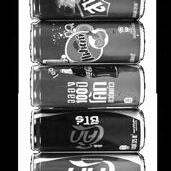
The process of turning scrap pieces of cardboard, aluminum and plastic begins at the assembly line. The scraps are then sent off to be recycled and reused.


2011 - AAF Flanders In 2016, American Air Filter Co. and Flanders Corp. combined forces to become AAF Flanders. The company has operations in 22 countries with 3,000 employees across the world. AAF Flanders opened the factory doors in Columbia in 2011. AAF Flanders makes portable air purification systems and other filtration devices.
For 10 hours a day, four days a week, employees at the Kawasaki Motors Manufacturing plant in Boonville turn bits of plastic and metal into functioning commercial lawn mower engines.
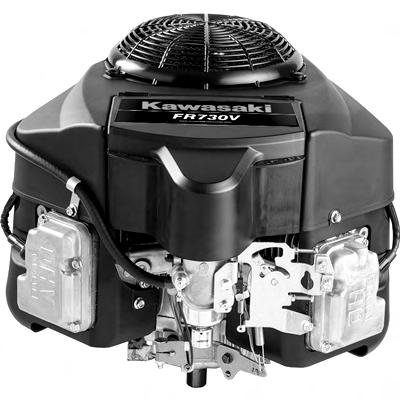
Shift leaders on forklifts and carriers buzz around the three assembly lines, picking up neatly sorted bags of leftover plastic, unusable aluminum parts and cardboard boxes. A large bailer compresses and ties the cardboard into two 1,800-pound bales every day. The aluminum parts are sent to the larger Maryville plant to be melted down and recast as ingots and will ultimately be used again.
The delicate system at the Kawasaki plant results in zero-turn mowers and lawn tractors. Over 300 employees working day and night shifts take the base crankcase and quickly work all the way to the completed engine, which is tested for quality. Senior manager Monte Hoskey says Kawasaki is a company dedicated to reducing its environmental footprint. “We could put 2,000 pounds a day in the landfill, but we choose to recycle the cardboard,” Kawasaki says. “We choose to recycle the plastic. It would be a whole heck of a lot easier for us and probably more cost effective to just throw it in the trash and not sort any of it.”
Kawasaki’s green mission borrows heavily from the United Nations Sustainable Development Goals published in 2015, which includes Goal 6: Provide clean drinking water and sanitation, and Goal 13: Take urgent action to reverse climate change. Yet, in a 2022 study by

2018 - Beyond Meat Ethan Brown founded this company in 2009 after working with MU professors and their meatless protein technology. The first product, Chicken-Free Strips, was distributed in 2012. The factory in Columbia was the second processing location, which resulted in a three-fold increase of manufacturing space. Beyond Meat has about 11 products that can be found in stores like Hy-Vee and restaurants such as TGI Fridays.

22 VOX MAGAZINE • JANUARY/FEBRUARY 2023
Photography courtesy of Unsplash and Kawasaki Motors Manufacturing
Brookings Institution, the U.S. was not on track to achieve even a single goal. It begs the question: What incentives are there for private industries to have less impact on the climate?
For one, approval in the public eye is important for manufacturers. By saying their products are “eco-friendly,” “organic,” “GMO-free” and “biodegradable,” they are also saying they are working for the good of the environment, or at least not to harm it. Companies often use greenwashing tactics to trick consumers into thinking their products do not have an impact on the environment. This includes the recent example of McDonald’s “eco-friendly” paper straws, which were found to be unrecyclable.
and Industrial divisions at Honeywell, to Vox in an email. “Once these findings are analyzed, additional sustainability projects will be developed to help drive the site toward carbon neutrality.”
At Boonslick Industries, plastic bottles and cans are recycled. This recycling workshop employs people with disabilities in Cooper and Howard counties, and their contractors buy plywood shipping pallets that turn into mulch used for landscaping.
A Guide to ‘Green’ Terminology
Sustainability terminology used by manufacturers often varies from industry to industry and from industry to consumer. Here is a glossary of commonly used terms that can trip up even the keenest consumer.
Biodegradable: The ability of a product to naturally break down over time. The time can vary from a few months to hundreds of years depending on the material and ecosystem conditions.
Eco-friendly: A term used to refer to earthfriendly or non-harmful practices used by manufacturers. It’s often a buzzword with no clear definition.
Emissions standards: The United States Environmental Protection Agency sets regulations on mobile sources of pollutants, including cars, trucks, planes and ships.
There are many angles a company can take when trying to show how sustainable it is. JM Eagle, a PVC piping manufacturer in town, says its plastics are of such quality that future piping will not be needed for 50 years. Honeywell, a manufacturer of electrical equipment and building controls with one location in Columbia that makes paraffin wax, has promised to go carbon neutral by 2035 to show its products are sustainable. A company achieves carbon neutrality when it offsets or eliminates carbon dioxide emissions to net-zero levels.“We are also collaborating with the University of Missouri to complete an energy assessment audit to understand our current energy usage and carbon footprint by the end of November 2022,” wrote Kori Anderson, vice president and general manager
Companies can also receive some government incentives for going green, including tax breaks and grants. The Biden administration’s Inflation Reduction Act extends 30% tax credits to companies that invest in wind, solar and other renewable sources of energy. Credits are also available for consumers who purchase an electric vehicle, which has some manufacturers perking their ears. Honeywell plans to electrify their entire fleet of vehicles by 2035 or earlier, a total of some 7,600 vehicles.
Non-toxic: A product is toxic if it is proven to cause injury or illness to humans when inhaled, swallowed or absorbed through the skin. A non-toxic product is not necessarily safe to put in or on the body, so it is up to the consumers to check the ingredients list.
of the Life Science, Protective
However, more research is needed before Kawasaki’s gas-powered lawn mowers go electric. “Eventually we will evolve to the point where, in 20 to 30 years, we may be making batteries on our assembly lines,” Hoskey says. “But at this point, it isn’t an even exchange for the amount of material and energy that it takes to produce an engine and power a mower.” Until then, Hoskey says the plant will continue to reduce its environmental footprint in the areas it can control by recycling all cardboards, plastics and unusable engine parts.
2019 - Aurora Organic Dairy Founded in Idaho in 1976, the company converted to 100% organic products in 2003, and Aurora Organic Dairy opened its second processing plant in Columbia in 2019. It creates and customizes organic brands, then prints its designs to package onsite. The milk can be packaged in several different sized bottles, cartons and jugs, or a multipack. Aurora Organic Dairy packages organic, private-label and store brand products for ˆ-Mart, Target and Costco.
Greenwashing: A company makes misleading or exaggerated claims about its product’s environmental impact. Greenwashing often tricks consumers and boosts a company’s reputation without actually have a positive effect on the environment.
Sustainable Development Goals: Laid out by the United Nations in 2015, the 17 goals were agreed upon by 191 member nations, including the United States. The goals act as a blueprint for development around the world and are incentivized for private industries to follow.
TRI-chemicals: Toxic Release Inventory chemicals,such as formaldehyde and nitroglycerin, are known to cause cancer or severe injury. The EPA actively works to limit TRI-chemical exposure by incentivizing the proper disposal of hazardous waste.
2023 - Swift Prepared Foods The 150-year-old Chicago-based company plans to be fully operational in Columbia by January 2023. The plant will produce dry-cured meats such as salami, prosciutto, pepperoni and pancetta. The Columbia location is said to be its largest location at 325,000 square feet and is expected to produce 40 million pounds of meat products each year.
23 VOX MAGAZINE • JANUARY/FEBRUARY 2023
After the overturning of Roe v. Wade, four Columbia religious leaders are reframing the connection between religion and abortion access.
 STORY BY ATHENA FOSLER-BRAZIL u DESIGN BY SIREEN ABAYAZID EDITING BY SOPHIE STEPHENS u
STORY BY ATHENA FOSLER-BRAZIL u DESIGN BY SIREEN ABAYAZID EDITING BY SOPHIE STEPHENS u




24 VOX MAGAZINE • JANUARY/FEBRUARY 2023
On a gray afternoon in May, the Rev. Molly Housh Gordon was one of many to speak to the solemn crowd protesting the leaked draft of the U.S. Supreme Court decision to overturn Roe v. Wade. The protesters held pink signs distributed by Planned Parenthood. At first glance, Housh Gordon didn’t appear like the typical pro-choice activist — she was clad in the distinctive black shirt and white collar of clerical attire.
Her message was clear: There is a spiritual community in Columbia that is widely supportive of reproductive rights. Housh Gordon is trained by the Religious Coalition for Reproductive Choice to provide all-options pastoral counseling to people making health care decisions. She extended the offer of spiritual counsel to everyone in the crowd, emphasizing that there are safe spaces for people of faith to talk through their reproductive options.
Housh Gordon has been ministering at Unitarian Universalist Church of Colum -
bia for 10 years. A pluralistic tradition that evolved out of Christianity, Unitarian Universalism includes a diversity of spiritual beliefs and is no longer a Christian denomination. The tradition is known for its progressive attitudes, which drew Housh Gordon’s family to the church when she was a child growing up in Tulsa, Oklahoma.


The beliefs of the congregation at Unitarian Universalist contradict the perceptions many Americans have about most religious groups in the U.S. The assumption that religious communities are anti-abortion fails to account for large swaths of progressive religious Americans, and the national media perpetuates this stereotype by failing to highlight these communities.

“People come to us for a variety of reasons,” Housh Gordon says. “Usually, there is something about the way that Christianity has kind of been co-opted by this very extreme, white nationalist framework.”

25 VOX MAGAZINE • JANUARY/FEBRUARY 2023
Religion’s role
According to Pew Research Center, roughly 63% of U.S. adults identify as Christian. Pew also reports that about 61% of U.S. adults think abortion should be legal all or most of the time. The idea that religious affiliation is synonymous with opposition to abortion is simplistic and the product of a powerful group of religious conservatives. “Right wing, extremist Christians have aligned the general understanding of Christianity with a very particular social worldview that is not actually very Christian,” Housh Gordon says.


Rick Oberle is a reverend at Columbia United Church of Christ, a denomination that he describes as being a combination of many Christian traditions. The United Church of Christ has a congregational system, meaning individual congregations are independent and govern themselves. He says each church is different and has varying political beliefs.
Oberle is open about his support for abortion access and speaks about it with his congregation. He says the pervasive assumptions about Christian views on abortion are a
result of Christianity being used as a tool to gain control.“I think a lot of people use — have always used — religion to control other people,” Oberle says. “So they create policies, and then they create the narrative to justify the policy. So as far as abortion goes, it has to do with controlling women.”
take the Bible and try to apply it literally,” Oberle says. “Most things in the Bible are not historical. Most of them are stories.”
Some fundamentalist and evangelical denominations of Christianity take a literal interpretation of the Bible. According to Gallup, roughly 20% of Americans in 2022 said the Bible should be taken literally. In comparison, 49% reported a view similar to Oberle’s, that the Bible was inspired by God but should not be interpreted literally.

Oberle uses Genesis 1 and 2 to explain his point. The two creation stories tell almost opposite accounts of how the world originated. When Oberle talks about scripture, he calls the stories parables. He emphasizes that he thinks the Bible was written to increase wisdom, not to be interpreted literally.
Oberle says there are a number of passages that anti-abortion Christians cite in support of restricting reproductive rights. Jeremiah 1:5 and Psalm 22 contain references to God creating people in the womb. He says this is the closest the Bible comes to addressing conception or abortion. “People
“It’s trying to tell us about God’s grandeur,” Oberle says. “That God is powerful, that God created everything. It’s about God; it’s not about a fetus.”
Although Housh Gordon doesn’t pastor at a Christian church, she’s in agreement with Oberle that Christianity is often weaponized as
The Rev. Molly Housh Gordon, who has been with Unitarian Universalist Church of Columbia for 10 years, gives a speech during a rally for abortion rights in May. After counter-protesters interrupted the speech, demonstrators came closer to support Housh Gordon.
26 VOX MAGAZINE • JANUARY/FEBRUARY 2023
PHOTOGRAPHY BY LEANNE TIPPETT MOSBY/ARCHIVE
YOU CAN VERY MUCH READ THE STORY OF JESUS AS THE OPPOSITION TO ... THE HIERARCHICAL POWERS THAT HARM PEOPLE, BODY AND SPIRIT.”
u u “
— Molly Housh Gordon, Unitarian Universalist Church of Columbia
a means of control. She and Oberle argue that the principles underlying the Dobbs v. Jackson decision that overturned Roe v. Wade are not based in the fundamentals of Christianity.

“The central narrative of Christianity actually is about how life and love are victorious against the forces of empire and death and oppression,” Housh Gordon says. “And you can very much read the story of Jesus as the opposition to the powers and principalities of this world, the hierarchical powers that harm people, body and spirit.”

Conversing with congregations

Sarah Klaassen has been a pastor at Rock Bridge Christian Church for six and a half years. Rock Bridge is part of the Christian Church (Disciples of Christ), a diverse and progressive-leaning, Protestant denomination. She says issues like LGBTQ+ rights, anti-racism and abortion access are topics that frequently come up as part of the theological discourse within her congregation.

“One of the things that we’ve been able to talk about is not thinking about this as a singular issue about pregnancy and abortion,” Klaassen says. “This has to do with layers and layers of agency and gender and who gets to make choices about what and where the decisions about healthcare rest.”
Klaassen says that she feels a responsibility as a Christian and faith leader to be vocal
The Rev. Sarah Klaassen speaks about abortion rights and antiracism with her congregation at Rock Bridge Christian Church. She says she does not see abortion access as a single issue but as one that represents layers of agency.
about her views on social issues. She says she pushes back against the idea that Christianity is incompatible with support for abortion rights.
Jessica Caldera is a member of the congregation at Rock Bridge Christian Church. She was drawn to the church for its progressive attitudes, which she hoped would provide a good foundation for her future children. But after years of struggling with infertility, Caldera
says she feels more strongly about issues of bodily autonomy than ever before.
Caldera says her personal fertility journey has made her even more committed to protecting women’s bodily autonomy, and she believes in the right to make reproductive health decisions without interference. “It’s just made it so much more personal and important to me,” she says.
The Rev. Rick Oberle is open about his support for abortion access and speaks about it with his congregation at the Columbia United Church of Christ.
27 VOX MAGAZINE • JANUARY/FEBRUARY 2023 PHOTOGRAPHY
BY BRADFORD SIWAK
Caldera is an attorney in Columbia, and she says what disturbs her most about the Supreme Court’s Dobbs decision is the blurring separation between church and state. “I think it’s totally inappropriate and scary that a certain sect of evangelicalism is determining how we’re governed,” Caldera says. “It just feels like a very loud minority group of people.”
Complications around pregnancy are extremely common, and the Dobbs decision not only restricts people’s choices about when to have children but also severely limits their ability to make choices that are medically necessary.
“If a child’s not viable at 5 months, no matter how badly those parents want to parent that child, continuing that pregnancy for an additional four (months) and going through childbirth not only poses a significant physical health risk to the mother,” Caldera says, “but also the emotional trauma of going to the grocery store and having random strangers touch your belly and say, ‘Congratulations, is it a boy or a girl?’ and you know that it’s not going to make it.”
She says that even though abortion is one of the primary causes of single-issue voters, the nuanced conversations that have arisen around reproductive health since the Dobbs decision are the one silver lining.
Tradition of choice
Although Christianity is the dominant religion in the U.S., for some people of other faiths, the Dobbs decision feels like a direct attack. According to Pew, 55% of Muslims, 82% of Buddhists and 83% of Jewish people in the U.S. say abortion should be legal most or all of the time.
Jeanne Snodgrass is the executive director of Mizzou Hillel. She says the Jewish faith is widely in support of reproductive rights.

Because Judaism does not typically oppose abortion, laws restricting abortion access are in direct violation of Snodgrass’s religious beliefs.
“There are plenty of Jewish individuals and organizations that I think have been very clear about the fact that for them, reproductive rights and abortion rights are part of what they would consider Jewish values,” Snodgrass says.
Snodgrass says rabbis have interpreted the Torah in more practical terms, applying the
text to real life. She gives the example that for those who keep Shabbat, during which driving is typically forbidden, it is acceptable to drive in order to save someone’s life. She explains that distinctions like this one illustrate the bigger picture values that underlie Jewish traditions.

“Being for abortion access, being for reproductive justice, is part of a connection to religious faith and religious tradition for a lot of people,” Snodgrass says. “It’s not the exception.”

28 VOX MAGAZINE • JANUARY/FEBRUARY 2023 PHOTOGRAPHY BY
Jeanne Snodgrass of Mizzou Hillel included portraits of people she’d worked with in a quilt she made in 2005. She says Judaism supports access to health care, including abortion.
VALERYIA ZAKHARYK
BEING FOR ABORTION ACCESS ... IS PART OF A CONNECTION TO RELIGIOUS FAITH AND RELIGIOUS TRADITION.”
u u “
— Jeanne Snodgrass, Mizzou Hillel
Food with a side of community


Carlito’s Cabo serves up authentic Mexican food and creates familial connections with its customers.

 BY PETRA RIVERA
BY PETRA RIVERA
29
Photography by Lily Dozier and illustrations by Grace Leyden
VOX MAGAZINE •JANUARY/FEBRUARY 2023
FOOD FOR THOUGHT P. 31
Chef Lupe Jiménez finishes plating two dishes at Carlito’s Cabo. Tonia Martin, who is a regular at Carlito’s, says nothing compares to Carlito’s food.
Roughly 20 years ago, the only places you could get authentic Mexican food in Columbia were a handful of small Mexican and Tex-Mex restaurants. After moving back from Southern California, John and Connie Burris used their love of California street tacos and their ambition to show Columbia what an actual taco tastes like and opened Carlito’s Cabo in 2003. Today, the Business Loop restaurant has changed a lot, but the mission stays the same: to serve unique, flavorful food by a reliable, hardworking staff.

Becoming Ms. Carlito’s “Around 2000, the grocery stores didn’t even sell taco shells, believe it or not,” John Burris says. “In California, there’s probably 100 different variations of what everybody considers California Mexican food. But, where we were from, it was good stuff. It was a flavor you couldn’t find back here in Missouri.”
Burris opened Carlito’s Cabo in October 2003. Sara Huaco, the current owner, started working there as a waitress shortly after they opened. She quickly dedicated her life to the restaurant. Her outstanding customer service skills made her memorable to the regulars, and she soon started to be known around town as “Ms. Carlito.” Huaco bought Carlito’s from the Burris family in 2008. “Everybody knew her from day one,” Burris says. “Everybody would come in, and if she wasn’t here they’d ask ‘where’d she go?’”
When Huaco took over, she started to incorporate little touches to the food from her family recipes from Peru. She added a full-on Peruvian-style dish to the menu, lomo saltado, and added Peruvian-style seasoning to the beans.

Bringing in authentic flavors
Over the years, the community at Carlito’s Cabo bonded over its love for delicious and quick food. The staff played a big part in creating the menu you see today. They spent days in the kitchen with Burris trying different recipes and combinations for the best adaptation of California street tacos.
Carlito’s current menu includes tacos, burritos, quesadillas and enchiladas. Every dish is served on a buttered yellow-corn tortilla. Carlito’s prides itself on being simple, unique, quick and affordable.
The kitchen prepares most of the ingredients every day to provide the freshest dishes to customers. Following the footsteps of its California inspiration, all its dishes are portable and easy to eat on the go, especially through its drive-through.
“You can always tell Mexican food by the smell,” Burris says. “What you’re smelling is a yellow-corn tortilla. It doesn’t matter what else you are cooking; if you don’t smell that good Mexican tortilla, it’s not authentic.”
Familia at the heart
“My favorite part about this business is the people,” Huaco says. “You meet different people every day. You have the chance to say hello and welcome back the regulars. Usually, I know someone as soon as they walk in, so I will just punch in
whatever they want because their orders usually don’t change.”
Longtime regulars who have been there since the beginning, like Lisa Hine, make up the majority of the customers. Hine has been a customer of Carlito’s since it first opened. The recreational therapist says she loves the restaurant because of the fresh ingredients and the speedy service. She says Huaco’s friendliness keeps her coming back. “She treats me like I am the only customer there,” Hine says. “She always seems like she remembers me even after it would be a while.”
Executive vice president of Coil Construction, David Coil, started going to Carlito’s as a child with his parents. Coil recalls how it has changed over the years since it has been a constant in his life.
“There was a big map of Mexico on the wall and the phrase ‘tiny tacos’ at one point,” Coil says. “I think they were like 89 cents or something. They were really, really cheap.” After knowing each other for years, Huaco and Coil love to joke around when he comes in, such as practicing his rusty Spanish when ordering his favorite carnitas.
The nostalgia, the authentic food and the familial atmosphere are what make Carlito’s run. “It’s a mom-and-pop place that my family appreciates,” Coil says. “We run a family business, so we certainly can connect on that level as well.”
30
VOX MAGAZINE • JANUARY/FEBRUARY 2023 EAT + DRINK RESTAURANTS
Photography by Lily Dozier
Sara Huaco, front, and Lupe Jiménez plate food. Huaco is plating lomo saltado, a Peruvian–style dish that adds a Peruvian flare to Carlito’s Cabo.
A plate of lomo saltado sits ready to eat at Carlito’s Cabo. Sara Huaco says that whenever her family is at home and wants this meal, they have Lupe make it at the restaurant.
No‘perfect’ day of eating
The trending “What I Eat in a Day” social media videos underscore the harm of idealizing food habits.
BY KARA ELLIS
The harmful promotion of diet culture is not new to the internet. People have long clung to ideal lifestyles and dangerous techniques of fitting the mold. Since the emergence of social media, influencers sell their brands and lifestyles on every platform. This includes what they eat. As far back as 2001, Microsoft found over 100 “pro-anorexia” websites on its server. A decade ago, teenagers would stum-
Even though these videos may be entertaining to watch, they have an underlying negative impact on nutrition and health.
ble upon the pro-anorexia accounts on Tumblr. Now there are concerns about “What I Eat in a Day” videos on TikTok, Instagram and YouTube.

“It’s like pulling out that measuring stick against something that may not be achievable for you or may not even be good for you,” says Beth Harrell, a registered dietitian in Lee’s Summit.
The trend is most commonly found on TikTok. Typically, an influencer re-
cords their meals throughout the day. The meals tend to be perfectly made and sometimes part of a sponsorship deal. The goal is to sell the product or perhaps just to sell their lifestyle.
Isabelle Bouchard, the founder of Bamboo Nutrition, a dietitian service in Columbia, has concerns about the messages behind these videos.
“One big diet culture myth is that every single day counts and what you do
31
EAT + DRINK ONLINE VOX MAGAZINE • JANUARY/FEBRUARY 2023
Illustrations by Grace Leyden
24-hour day.” Instead, Bamboo Nutrition centers on a longer span of time.
This seems to be the issue with so many of these videos. Viewers look to the creators as an answer to a question we all hate to ask: How can I change? But these videos provide no truth. There is no right way to eat or manage the food in your day.
Dr. Ellen Fitzsimmons-Craft has worries about how people react to
these videos. As an associate professor of psychiatry at Washington University, she has focused her expertise on eating disorders. “It’s just going to promote comparison, often leaving the individual watching the video to feel that they’re kind of coming up short in some way,” Fitzsimmons-Craft says.
Comparison seems to be the danger in all these videos. Watching someone promote their diet, their life or their health can solidify the viewer’s own restricting behavior. This is even more amplified for individuals who have already struggled with their relationship with food.
TikTok has addressed part of the problem, asking viewers not to post or share a video that “depicts, promotes, normalizes or glorifies disordered eating.” Yet, with a simple search of certain diet-related words, these videos can still be found.
In 2021, The Guardian conducted research that found that engaging in the hashtag #WhatIEatInADay could lead to videos with #ketodiet and eventually to unhealthy videos with #Iwillbeskinny or
YOU’RE NOT ALONE
Check out these resources if you’re seeking recovery.
Bamboo Nutrition
Meet with a dietitian to create a refreshed mindset around your nutrition and health, 615-4443.
Kind Body Collaborative

Work with MidMissouri’s multidisciplinary team that specializes in eating disorder recovery, 615- 4656.
National Eating Disorders Association
Contact for support, resources and treatment options near you, 800-931-2237.
#thinspo. Once TikTok started banning hashtags that promoted unhealthy eating habits, users began using misspelled words, such as #thinspoa, to get around new regulations.
Viewers cannot rely on these platforms, though, to fully protect them from this content, so taking individual stock is important, Fitzsimmons-Craft says. “We know that people are always going to find new ways to share this content.”
What we can do, however, is decide what we follow and who we choose to give our time to. It is possible to take the initiative to unfollow these harmful accounts and swipe past them before they get the chance to bother us. There is positive food content on the internet. We just have to seek it out. We can find professional content that promotes realistic eating or hashtags that prioritize body positivity.
“If you find it’s not motivating and it’s more bringing you down, don’t follow them anymore,” Harrell says. “Unfollow and find a different algorithm.”
32 VOX MAGAZINE • JANUARY/FEBRUARY 2023 EAT + DRINK
SO CAN YOU.
Illustrations by Grace Leyden
Season of the witch
For decades, Columbia’s pagan community has been forging its own spiritual path. Increasingly, Gen Z is joining the journey.
 BY EMMA LINGO
BY EMMA LINGO
The bells on Apple Blossom’s door dance in the autumn wind. She turns on strings of fairy lights inside, and then lights the candles around her reading table. Her shop, The Psychic Room, at 906 E. Walnut St., is now open for the day.
For many, “paganism” might connote spells and witchcraft, but it can mean many things. According to Merriam-Webster, paganism is any set of beliefs and practices other than those of the major world religions. Blossom describes her beliefs as an open process, as she’s open to all religions. Through predictions and advice, her shop is meant to guide people on their spiritual journeys and enlighten them on what to expect for future opportunities.
At 1004 W. Worley St., Deborah Carney brews a pot of coffee for herself
Oak Spirit Sanctuary is a non-denominational pagan church. They host celebrations of numerous holidays, including Samhain and Yule.

and the other spiritual seekers before a Heart, Body, & Soul class on working with crystals — best to have caffeine before they get started.
If Carney and fellow shopkeeper Moonwillow Love had to label themselves, they’d say they are “Christian witches” who forge their own personal relationships with God, independent of organized religion. Paula Curry, another shopkeeper at Heart, Body, & Soul, describes herself as an “Indigenous spiritual seeker,” who follows Indigenous teachings such as those of Native Americans and Tibetan Buddhists.
Staff members at both shops say they’ve seen a rise in curiosity surrounding their practices, with more people coming in to explore different spiritual paths. It seems that youth are interest-

33
Photography by MaKayla Hart/Archive and courtesy of Unsplash VOX MAGAZINE •
JANUARY/FEBRUARY 2023
GLOBAL WARMING GOES TO SCHOOL P. 35
A variety of classes are taught at Heart, Body, & Soul. Paula Curry taught a class on working with crystals, and their uses for healing and guidance.
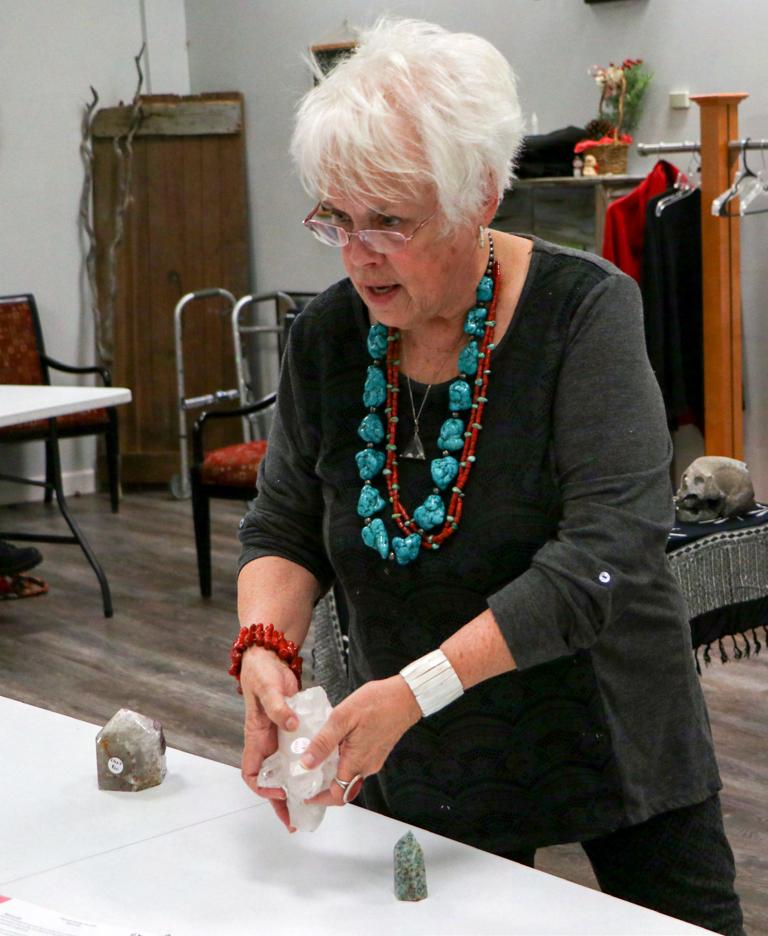
ed in joining them. Finding a craft — a personalized set of spiritual beliefs and practices — takes time, but it looks like Generation Z is up for the task.
Witches online
Videos tagged as #WitchTok have 34 billion views on TikTok, #Witchcraft has 8 million posts on Instagram and spiritual social media influencers such as @kaijathepagan and @jasminesgarden23 have millions of followers.
“Children, and especially young adults, do not fit in the mold that we did,” Carney says. “They’re looking, they’re searching. I think social media and (the pandemic) have a lot to do with it.”
Love says that personal spiritual journeys allow people to decide for themselves what makes them feel closest to God. As one of the many witches still in “the broom closet” because her family wouldn’t understand her practices, she says that organized religion can leave some feeling confined and traumatized.
A spiritual guiding point
Oak Spirit Sanctuary sits on the western bluffs of the Missouri River, a 30-minute drive from Heart, Body, & Soul. This 160-acre, non-denominational pagan church encourages its members to take their own unique spiritual path.
Patrick Finney, who’s on the Board
of Directors for OSS, discovered the church in the early ’90s with his wife, Dawn. After settling in Columbia in 2011, they slowly worked their way up in the organization and now serve on the board. Finney is even an ordained clergy member, using the title brother as opposed to reverend.
Finney calls himself a universalist, pan-spiritual religious anarchist. He uses the term universalist because he believes in a number of different spiritual paths, all of which are valid. Pan-spiritual refers to the fact that he practices numerous traditions, and religious anarchism means he forges his own path and does not submit to religious authority, unless by his own volition.
“It’s difficult for me to label myself,” he says. “But it has less to do with my feelings about God and more to do with my feelings toward religion.”
CURATE YOUR CRAFT
Heart, Body, & Soul: Register for a class happening most months at heartbodyandsoul. org.
Oak Spirit Sanctuary: This worship space welcomes volunteers. If interested, visit oakspiritsanctuary. org.
The Psychic Room: Make an appointment for predictions, advice and more at themissouri psychicroom.com.

Spirituality and festivities
At the OSS annual Samhain Festival in October 2022, nearly half of the attendees were children, most of whom grew up outside organized religion. Finney’s grown daughter, Isolde, was raised in multiple religious traditions.
“We had Hindu gods above the door,” she says. “There’s a Buddhist statue in our garden. There are gargoyles. There are pentagrams. We do Christmas, but we also do Yule. It’s just a mix of everything, which is really cool.”
Youth interest in paganism doesn’t seem to be slowing down. It’s not just visible on social media, but throughout our local community as well. Blossom’s shop opened with success in August 2022. Heart, Body, & Soul will soon be a decade old, and OSS continues to grow its flock. Witches or not, more people are finding comfort in the old gods.
34
CITY LIFE SPIRITUALITY VOX MAGAZINE • JANUARY/FEBRUARY 2023
Photography by Ben Koelkebeck
E is for Earth: Teaching kids about climate
Columbia Public Schools builds environmental science knowledge throughout elementary and middle school, from lessons about litter to analyzing data.
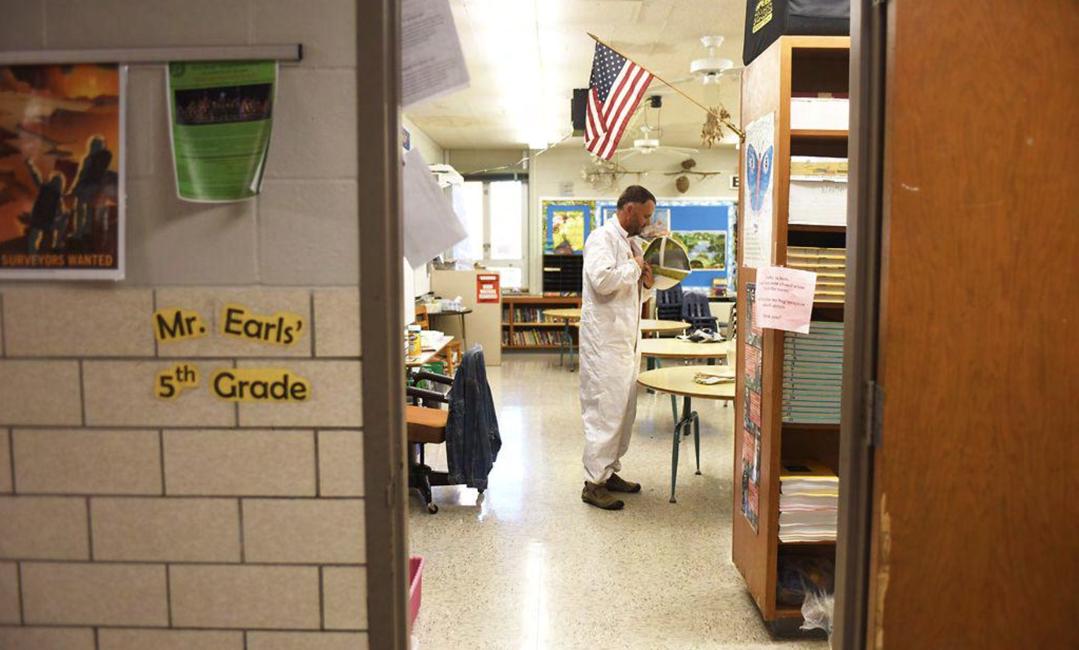 BY ATHENA FOSLER-BRAZIL
BY ATHENA FOSLER-BRAZIL
Evidence of climate change is all around us, and children today are growing up faced with a daunting global problem. As the issue continues, schools are helping educate students. In 2021, The Lancet collected data from 10,000 people ages 16 to 25 in 10 different countries. The results showed that young people across the world are worried about climate change, with 59% saying they are very or extremely worried and 84% at least moderately worried.
For children facing these large-scale issues, school is a place where they can go with questions and learn the science to understand what’s going on around them. Public schools are tasked with lay-
ing the foundations of climate science education throughout elementary school and introducing students to the concept of climate change in middle school.
Educators in Columbia, in conjunction with Missouri state curriculum requirements, are trying to put climate change into context for kids. Here is a basic timeline of environmental science education in Columbia Public Schools, from kindergarten through eighth grade.
Reduce, reuse, recycle
In early elementary, children are taught to observe interactions between humans and the environment. Ragan Webb, Columbia Public Schools science curricu-
lum coordinator for grades K-5, says it’s as simple as students observing how the placement of a trash reduces litter on the ground.
“They do talk even as early as kindergarten about solutions that would lessen our impact as human beings on our environment, like recycling and reusing things instead of buying new things all the time,” Webb says.
Dressing for the weather
In third grade, students learn the difference between weather and climate. Some teachers use analogies to explain the concept. “What you specifically put on in one day is weather,” says Andrew Kinslow, Columbia Public Schools science curriculum coordinator for grades 6-12. “Climate is when you open up your closet and look in your closet at all the different types of clothes that you have for all of the seasons.”
Third grade also introduces weather-related hazards such as storms and fires. Webb says teachers make an effort to root the concepts in things students can observe in Missouri, such as drought.
35
VOX MAGAZINE • JANUARY/FEBRUARY 2023 CITY LIFE SCHOOLS
Photography by Jay Bury/Archive
Brian Earls wears a beekeeping suit to engage with his fifth grade science class. Earls incorporates bees into his curriculum as a way to teach about the life cycle.
High energy
In fourth grade, students are taught about energy production and resource use. “Fourth grade is where they start talking about renewable and nonrenewable resources and how we use those to produce the energy that we use,” Webb says. She says students are exposed to a range of energy production methods such as coal, solar and nuclear.
A local look
Joe Barnett teaches science at West Middle School and makes an effort to localize concepts when possible. Barnett does this with his students during a species interaction unit. Taking a macro-level approach, the class looks at how humans influence the natural system. For example, the class studied plants off campus in an area heavily influenced by humans. “They looked to see how many different kinds of organisms, particularly plants, they were able to find as they ventured further and further,” Barnett says.
Kinslow says teachers employ local examples to provide context to the concepts taught in the classroom. He calls this practice an “anchor phenomenon.”
THEY’RE COMING IN WITH QUESTIONS
Dissecting the data
Middle school is when students are introduced to more specific references to climate change. Kinslow says at this point, students have the necessary foundational information from elementary school to look at data on long-term environmental change. “The evidence is telling us that humans are having an impact on the environment due to changes in the carbon cycle,” Kinslow says. With that in mind, students can look at how climate change is affecting the world around them through
Science teacher
Heather Jones wades into a cloud of smoke to monitor the flames from a controlled prairie burn. Columbia Public Schools partnered with the state Department of Conservation in a series of educational lessons for CPS faculty in 2020. Teachers often use examples of climate change that students can observe in their own backyards to get them connected with the concepts.

a local lens, like prairie ecosystems, down to specific areas in the school yard.
In eighth grade, Barnett says students begin analyzing data trends. Eighth graders look at trends in climate patterns from an Earth history perspective. “So when you’re looking at the history of the Earth, they’re going to — when we get to that portion of the curriculum — be finding these patterns, looking at the data trends and seeing what’s happening now and what fits and what does not fit,” Barnett says.
Across grade levels, teachers try to emphasize that there are small ways students can interact with and think about their environment.
“They’re coming in with questions like ‘What does this mean for me?’ ‘How is it working?’ ‘What can we do about it?’” Kinslow says. “Those are very important things for us as science teachers and us as a school district to be able to give them the ability to look at evidence critically and make decisions based on that evidence.”
Fifth graders mix pebbles and sand before adding water to create waves. The hands-on activity helps students learn about erosion.

36
VOX MAGAZINE • JANUARY/FEBRUARY 2023 CITY LIFE SCHOOLS
Photography by Kit Wiberg/Archive and Derek Rieke/Archive
LIKE ‘WHAT DOES THIS MEAN FOR ME?’ ‘HOW IS IT WORKING?’ ‘WHAT CAN WE DO ABOUT IT?’”
“
— Andrew Kinslow
ART On Your Feet!
TO-DO LIST

Your curated guide of what to do in Columbia this month.
The unlikely rise to stardom of Gloria and Emilio Estefan is the inspiration for this musical. Follow their story on their way to 26 Grammy Awards. Featuring Gloria Estefan’s biggest hits as well as new music, don’t be surprised if that rhythm gets you moving during this show. Jan. 18, 7 p.m., Jesse Auditorium, $58–$72, 882-3781
Greg Warren
Comedian Greg Warren returns to the Columbia stage as part of the CoMo Comedy Club series. An MU alum, Warren started his career at Procter & Gamble before going into comedy full time in 2001. The show name, “The Creamy and Crunchy Tour,” is a nod to his time selling products such as Jif and Pringles. He has appeared
on Late Night with Seth Meyers, The Late Late Show and Last Comic Standing Jan. 27, 7 p.m., The Blue Note, $20, 874-1944
The Merry Wives of Windsor
This Shakespearean comedy tells the story of Sir John Falstaff and his ploy to seduce the wives of two wealthy citizens in Windsor in an effort to restore his fortunes. But the wives discover the plot and seek revenge through a series of pranks. Along the way, the play explores themes of love, marriage, jealousy and social class. Feb. 9–11, 7:30 p.m., Feb. 12, 2 p.m., Warehouse Theatre, $18 general admission, $15 for students and seniors, 876-7199
The Lightning Thief: TYA Edition
Enter the world of monsters and demigods with
this stage production of Rick Riordan’s wildly successful book of the same name. Follow Percy Jackson, the son of Poseidon, on his quest to find Zeus’ missing master lightning bolt or be blamed for the theft himself. The consequences are great and the stakes are high for not only Percy, but for his friends, too. Feb. 10, 7 p.m., Jesse Auditorium, $25–$35, 882-3781
Dublin Irish Dance
Through steps and songs, Stepping Out tells the story of Irish immigrants coming to America in the mid-1800s and how they brought their culture and music with them. This troupe of world champion Irish step dancers is accompanied by a traditional Irish band and singer. Experience a bit of Ireland without having to book a flight. Feb. 19, 7 p.m., Jesse Auditorium, $18-$38, 882-3781
37 CALENDAR VOX MAGAZINE • JANUARY/FEBRUARY 2023
Save a life. Don’t Drive HoMe buzzeD. BUZZED DRIVING IS DRUNK DRIVING.
CALENDAR

FOOD
MO Bacon & Bourbon Festival
The MMAMTA Odyssey s
Pre-Collegiate Aria / Concerto Competition
AUDITION
January 8, Sunday 3 p.m.

SNOW DATE
January 15 (Sun) 3pm
CONCERT: BAROQUE CONCERTO

February 17, Friday 7 p.m.
First Baptist Church of Columbia, 1112 E Broadway
WWW.ODYSSEYMISSOURI.ORG


Missouri Pork invites you to sample unique and savory bacon and bourbon delicacies. Vendors will be selling bacon treats, fine spirits, craft cocktails and bubbly beer for eventgoers to savor. Tickets give attendees entry for the live music performances and unlimited samples of spirits and food products from vendors. The proceeds of the festival will benefit Mid-Missouri Honor Flight. Feb. 4, 1–4 p.m., Bur Oak Brewing Company, $20-$40, 814-2178
MUSIC
Tribute to The Cranberries
Columbia-based group Violet and the Undercurrents brings back this tribute to The Cranberries. The Irish rock band rose to popularity in the 1990s with songs such as “Linger” and “Zombie.” DJ Note Girl also will perform. Feb. 4, 8 p.m.,The Blue Note, $7 advance, $10 day of, $15 tables, 874-1944
Empire Wild
This genre–bending trio takes the stage performing in support of their debut EP Paper Seasons Mixing pop, folk, jazz and more in their original songs, the two cellists and one singer-pianist create a sound that’s sure to be a unique experience. Feb. 7, 7 p.m., Missouri Theatre, $28–$35, 882-3781
Take 6
The 10–time Grammy Award–winning sextet brings its American gospel a cappella to Columbia. With a lineup of songs from the 1980s to present day, Take 6 will lead you on a nostalgic journey, and you’ll understand why the group has won Grammys, Dove Awards and is in the Gospel Music Hall of Fame. Feb. 16, 7 p.m., Jesse Auditorium, $38–$50, 882-3781
RECREATION
ROC7K Trail Run
Challenge yourself in the new year with the ninth-annual ROC 7K Trail Run. This singletrack course takes runners on a 7K scenic route on a well-maintained track at Cosmo Park’s Rhett’s Run. The chip-timed race gives unique awards to the overall top male and female finishers as well as the top three men and women in each age group. Jan. 22, 9 a.m., Cosmo Park, registration $35 in advance, como.gov/parksand-recreation/special-events, 874-7460
38 VOX MAGAZINE • JANUARY/FEBRUARY 2023
A TASTE OF HOME
PHOTOGRAPHY BY SYDNEY LUKASEZCK
A bowl of matzo mix and family photos surround a recipe for Never Fail Matzo Balls, a Rosenthal family tradition. Rodger Rosenthal says this recipe, which was passed down from his mother, Esther, is a reminder of his family’s Jewish heritage. As a single dad living in California and far away from his immediate family, Rosenthal used cooking to entertain his son, Benji, and teach him about his late grandparents. After moving to St. Louis in 2017 for Benji to attend MU, Rosenthal made an effort to cook more traditional Jewish meals since he had relocated closer to his remaining family.

39 VOX MAGAZINE • JANUARY/FEBRUARY 2023
photo finish






the 20th True/False March 2-5, 2023 | Columbia, mo. truefalse.org PASSES NOW ON SALE A four-day celebration of art, music, and film, transforming downtown Columbia into a one-of-a-kind creative wonderland. MISSOURIAN



































 BY LUCY VALESKI
BY LUCY VALESKI









 BY LAUREN BLUE
BY LAUREN BLUE





 BY AMILEE NUZZO
BY AMILEE NUZZO



 BY AMILEE NUZZO
BY AMILEE NUZZO


 Design by Heeral Patel
Design by Heeral Patel


















 STORY BY ATHENA FOSLER-BRAZIL u DESIGN BY SIREEN ABAYAZID EDITING BY SOPHIE STEPHENS u
STORY BY ATHENA FOSLER-BRAZIL u DESIGN BY SIREEN ABAYAZID EDITING BY SOPHIE STEPHENS u

















 BY PETRA RIVERA
BY PETRA RIVERA




 BY EMMA LINGO
BY EMMA LINGO




 BY ATHENA FOSLER-BRAZIL
BY ATHENA FOSLER-BRAZIL














